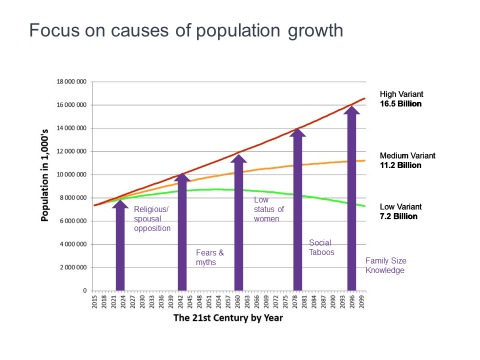How Raising the Status of Women Can Help the Environment
The following essay was adapted from PMC’s annual campaign mini-site.
Arguably, gender inequality lies at the heart of humanity’s already oversized total population —and its ongoing rapid growth. If we are to realize an end of population growth and subsequent global decreases in population size, women’s sexual and reproductive health and rights will need major work. This means, in part, that oppressive cultural practices such as gender-based violence, female genital mutilation, and child marriage have to be addressed.
After all, how well a society treats its women is one of the strongest indicators of the success and health of that society. Even now, gender inequality remains a major barrier to human development. While girls and women have made some advances over the last 20 years, they still suffer from prejudice and discrimination in health, education, political representation, labor markets, etc. — with negative repercussions for development of their capabilities and their freedom of choice. With these rights impinged upon, or totally absent, family size decisions are often controlled by husbands or in-laws and end up being larger than if women could truly decide for themselves how many children to have and when. These injustices add to global population growth and increases human pressure on the Earth’s natural systems.
When realizing the scope and scale of human overshoot, and the enormity of current human population size and projected growth, many people tend to instinctively and understandably, sense a need to “push down” on fertility.
Conceptually this becomes problematic, because you end up with sincere and heartfelt advocacy for things like physical coercion, human rights violations, brutally enforced one-child policies, and a whole host of similar ideas. In other words, the saliency of the population issue lends itself to the idea that in order to save humanity we must behave inhumanely – similar to the notion that grew out of the Vietnam War, wherein “It became necessary to destroy the town to save it.”
But pressing down on fertility is not actually what is required.

If we shift our conception of the problem away from the need to “push down” on fertility and instead look at the forces that keep fertility needlessly and artificially inflated, delusions about martial control of fertility on a global basis fall to the wayside. Rather, interventions that help remove the forces that keep fertility artificially high can be seen as effective in terms of global population dynamics, and intrinsically accretive to the realization of human rights. Click through to see examples of these regressive pillars in action:
Religious and spousal opposition to family planning
Fears and myths around modern contraception
Social Taboos around contraception
Lack of awareness around the benefits of small family size decisions
If you want a real-world example of how effective this sort of strategy can be, look no further than the world record fertility decline engineered by Iran in the late 20th century. There, in 1986, the central government adopted an explicit goal to reduce the rate of natural population growth from 3.2 to 2.2% per year and to achieve a total fertility rate (TFR) of 3.5 births per woman by 2009. Instead, the goals were accomplished by 1993 – 16 years ahead of expectations.
Among other tactics, the status of women was boosted considerably as primary and secondary education was opened up to woman and girls; print media, TV, radio, and schools educated youth and families about population growth and family planning; and, oral contraceptives were manufactured nationally and the government established their own condom factory to ensure strong contraceptive supply chains. (Case study: fertility decline in Iran. Farnaz Vahidnia. Popul-Environ DOI 10.1007/s11111-007-0050-9)
Beyond PMC’s work to familiarize audiences with family planning and modern contraception, and improve the status of women on a number of fronts, our entertaining dramas can also role model the benefits of small family decisions.
For example, Ruwan Dare (“Midnight Rain”) was a 208-episode radio serial drama that aired in four northern states of Nigeria from July 31, 2007 through July 18, 2009. PMC surveys indicated that the program reached more than 12 million people.
At baseline survey, the mean desired number of children for all respondents was 7.43 (females 7.71, males 7.03), which decreased significantly to 5.93 by the endline survey, most notably among females (females 5.39, males 6.96). The likelihood of respondents saying they did not want to have another child was 5.7 times greater at endline compared to baseline, and listeners were nearly two times as likely as non-listeners to think that “people should plan how many children they have.”
These figures show both how effective theory-based entertainment programs can be at changing attitudes and perceptions of social norms – and how urgent the need is for more robust programming.
The following essay was adapted from PMC’s annual campaign mini-site.
The MAHB Blog is a venture of the Millennium Alliance for Humanity and the Biosphere. Questions should be directed to joan@mahbonline.org
MAHB Blog: https://mahb.stanford.edu/blog/two-crises-one-solution-pmc/
The views and opinions expressed through the MAHB Website are those of the contributing authors and do not necessarily reflect an official position of the MAHB. The MAHB aims to share a range of perspectives and welcomes the discussions that they prompt.
